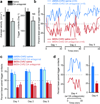Distinct roles for direct and indirect pathway striatal neurons in reinforcement
- PMID: 22544310
- PMCID: PMC3410042
- DOI: 10.1038/nn.3100
Distinct roles for direct and indirect pathway striatal neurons in reinforcement
Abstract
Dopamine signaling is implicated in reinforcement learning, but the neural substrates targeted by dopamine are poorly understood. We bypassed dopamine signaling itself and tested how optogenetic activation of dopamine D1 or D2 receptor–expressing striatal projection neurons influenced reinforcement learning in mice. Stimulating D1 receptor–expressing neurons induced persistent reinforcement, whereas stimulating D2 receptor–expressing neurons induced transient punishment, indicating that activation of these circuits is sufficient to modify the probability of performing future actions.
Figures



Comment in
-
Reward and punishment illuminated.Nat Neurosci. 2012 May 25;15(6):807-9. doi: 10.1038/nn.3122. Nat Neurosci. 2012. PMID: 22627791 No abstract available.
References
-
- Azrin NH, Holz WC. In: Operant behavior: areas of research and application. Honig WK, editor. New York: Appleton-Century-Crofts; 1966. p. 865.
-
- Skinner BF. New York: Macmillan; 1953.
-
- Eshel N, Roiser JP. Biol Psychiatry. 2010;68:118–124. - PubMed
Publication types
MeSH terms
Substances
Grants and funding
LinkOut - more resources
Full Text Sources
Other Literature Sources
Molecular Biology Databases

